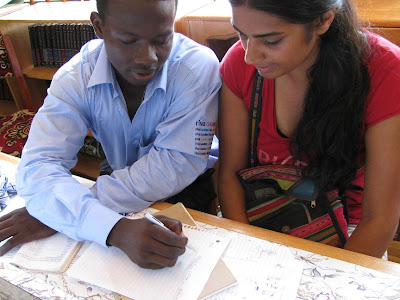








Hello All,
Two days ago, we did a quick little day trip to Cape Coast which is 2-3 hours west of Accra on the southern Coast of Ghana. Its a nice town with more of a coastal feel to it. The first stop was Kakum National Park. It is one of the few remaining rain forests in Western Africa. The mist of the rainforest reminded me of home and was a welcome shift from the dry heat. A group of foreign enigeers teamed up with some Ghanian engineers to make a group of rope bridges that traverse the canopies of the forest. They are seven plank and rope bridges that are only large enough for one person to go single file. Walking above the forest was a wonderful experience and seeing the tops of lush trees, wandering butterflies and soaring birds instantly calmed me and left me serene and peaceful for most of the day. The educational center was a great way to emphasize how the destruction of the rainforests are damaging the ecosystem.
After a brief stop at a crocodile farm where I fell in love with the frenzy of the nesting rituals of the Ghanian Yellow Bird, we headed off to Elmina Castle where the slaves were held before being sent off to the New World. It was a large castle and fort built in the 1600's that many Europeans had tried to gain control of(the Danes, Swedes, Dutch,Brits, Portuguese) . It finally was acquired by the British and used for the slave trade.
The origins of the slave trade are interesting. Apparently when the Ghanaian Kings were warring the winning king of the battle acquired the remaining soldiers of the losing side. These were the first slaves sent to the coast and traded for weapons and supplies. Once the demand increased and it was apparent that this was a lucrative opportunity, African middle man began capturing people and marching them to the coast (yes literally capturing them like animals) and they would arrive at this castle. There were two major slave trade movements--one was transatlantic and one trans-saharian. The trans atlantic movement of people had an immense impact on the population and some say the development of Africa.
Once here, they were shaven, bathed and oiled and prepared for sale. There were two types of slaves-domestic and manual labor force. They were separated by gender and kept in 2 dungeons that were dark with a recessed perimeter for the feces and urine to collect. There was a small window (more like a hole) at the top of the chamber where food and water were thrown in. The water was so little and would fall on their heads that some people would suck it off the hair of the others. They were moved from chamber to chamber as they were being prepared for sale and shipment. The sick ones would remain in the dungeon while the stronger ones were moved forth.
The last door they would pass through is called "The door of no return". I walked through that door and felt an immense amount of sadness. To think that once passed through this passage, they were sent to a land that they did not know and left behind all their people, customs and beliefs.
On the journey, if a woman was discovered to be pregnant or if food was scarce on the ship, they would throw a few slaves overboard to the sharks. It was common that sharks would follow the ship most of its journey since they knew food could easily be found.
As I continue to discover more about the slave trade, I am overcome with grief and unable to imagine how people could treat our fellow brothers and sisters like animals on a mass scale. There are two thoughts on the impact of slavery on the development of Africa. In total it is estimated that in the 4 and a half centuries of trans-Atlantic slave trade some 6 million Africans were transported away from Africa. How could a continent be able to prosper with that much of the strong, healthy and able population removed. From a genetic point of view, what does that do to the remaining population of non-healthy people and how does this correlate to some of the diseases we see? Another point of view--asks if the continent is having difficult developing now, how would it have done with the added population (implying that it would have been worse off than it is today which I don't personally agree with).
I am interested in comparing the slave trade impact in Ghana with the other large coastal port of Dakar when I get there. I hope sharing these facts and stories with you will help us all be aware of the consequences and inhumanity of slavery on a more personal level. I have included a few pics of the ominous clouds over the castle (I thought very appropriate).






















